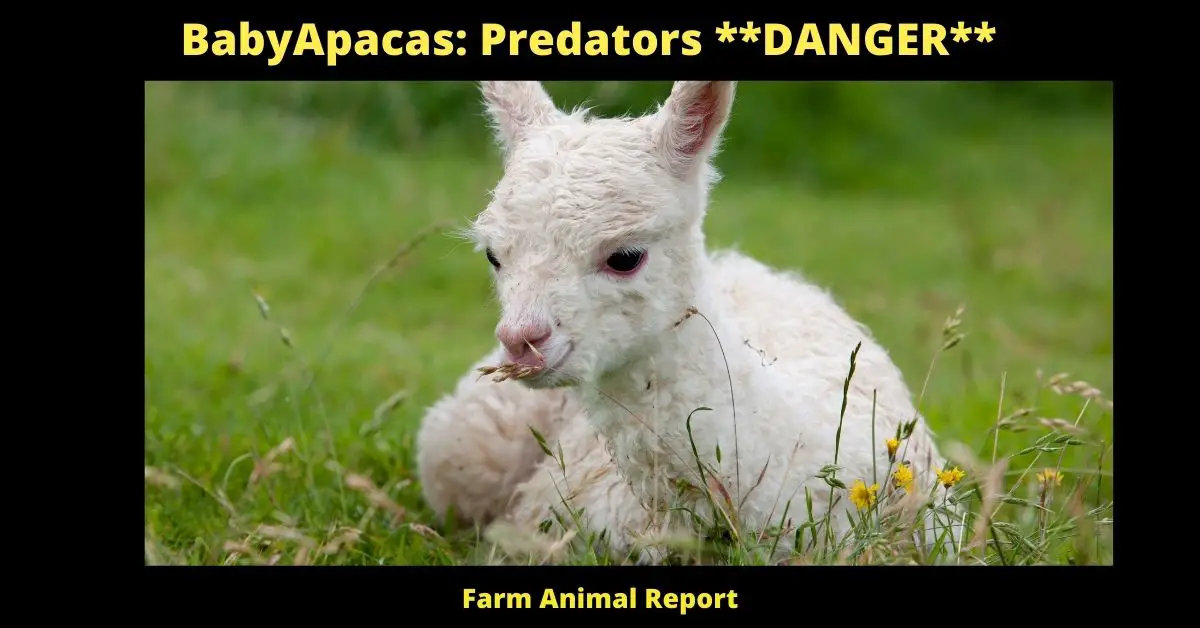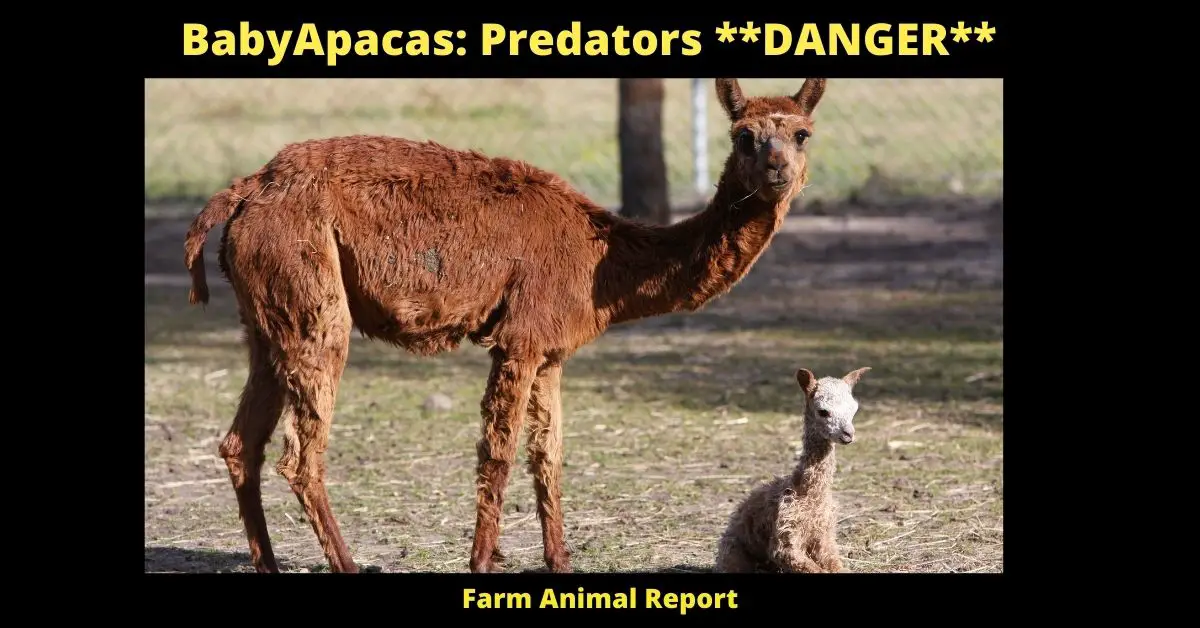Baby Alpacas: Predators
Everyone knows that BabyApacas is a cute, cuddly creature. But did you know they also have to deal with predators? There are all sorts of animals and insects who want nothing more than to make a meal out of these little guys! To help protect them from the dangers in their environment, we’ll be discussing some of the most dangerous predators out there and how to avoid them.
As a general rule newborn baby alpacas are defenseless. They rely on their mothers for protection until they mature and can defend themselves. The mothers will spit, kick or attack with their hooves. Lay upon their baby or even sacrifice themselves for their Baby Alpaca
Baby Alpacas: Predators – The first predators that BabyApacas will encounter are other alpacas! They live in large groups called herds, and the herd is usually run by a dominant male who controls all mating within the group. The males sometimes battle to show dominance, which often ends up with one male getting injured.
See Our Section on Newborn Alpacas-Baby Alpacas-Extensive Guide
The second predators that BabyApacas face are foxes and other small animals, such as dogs or coyotes, who prey on young alpacas for their soft fur and meaty bodies. It’s important to keep your alpaca safe from predators at all times! Make sure they have a sturdy fence so no wild animals can get in.

Baby Alpacas are Defenseless when Born,
baby Alpacas have no effective defense mechanisms. Mother alpacas can only protect their young from predators for the first few months of life because, after that, they become quite large enough to fend for themselves.
Mothers will often try to distract predators by lying down on top of their young.
Alpacas are not the only ones who can use this trick; many other types of prey animals will do it as well.
It is recommended that you never approach an alpaca in labor, especially if there is blood or afterbirth involved. This may cause them to feel threatened and they will not hesitate to defend themselves or their young.
If you find an abandoned baby alpaca, do NOT touch it! Call for help immediately so that a rescue can be performed in the safest way possible. Alpacas are very sensitive creatures who trust only those with whom they have had contact from birth. If you do not have this kind of relationship with them, you will be seen as a threat and they may defend themselves.
See Our Section Alpacas Giving Birth A MIRACLE
Baby Alpacas Cannot run
Baby Alpacas when they are born are very weak and cannot run away from predators. They also cannot provide any kind of defense for themselves so the mother alpaca will do what she can to protect her baby but after a few months, they have become large enough that their mothers are no longer able to care for them as much.
Jump to Section Weaning Alpaca Crias ***TEAT FEEDING**
Baby Alpacas can stand at birth and within the first week, they are able to walk. At about three months old, baby alpacas can run and be on their own for short periods of time but must still return to their mother’s side often, or else predators will attack them.
After being on their own for a few more weeks, Baby Alpacas are fully grown at around 18 months old and are able to escape predators by running away.
Baby Alpacas Hooves are not Developed
Newborn Alpaca’s hooves are not developed. They do not walk around on their own for several months and the hooves remain soft, which makes them very susceptible to injury and infection of these injuries. The newborn alpaca will be standing and walking around the herd within a few hours of birth.
A Baby alpaca will need its first hoof trimming at approximately four months.
After the first six weeks, Baby Alpacas’ hooves are trimmed every three to five weeks until they reach one year of age.
Baby Alpacas Cannot Spit
Newborn Alpacas are nursed by their mothers for the first six months of their lives. During this time they are completely reliant on the mother for nourishment and protection from predators such as foxes, dogs, birds, and even bears! The mothers will do all that they can to keep them safe by spitting at those who pose a threat.
The babies start producing milk teeth around three years old which allows them to start grazing. When this happens, the mother will gradually reduce her milk production and eventually stop producing it altogether between 18 months and two years old. Baby Alpacas can begin breeding when they are about 12 months old, but many owners do not allow their stock to breed until they reach around four or five years of age in order to maximize their growth and protect against predators.
When in the wild, alpaca herds are built around a single female with her babies. This alpha female will defend them to the death against any possible enemies including pumas! If she were not present, then many of these young would be killed by birds or other animals before they even reach adulthood, so she is an extremely important member of the herd.
Baby alpacas will begin grazing when they are about one year old.
At that age, they will be able to spit to protect themselves in this manner
Baby Alpacas have many Predators
The predators of baby alpacas include:
Domestic cats and dogs can be a threat to baby alpacas.
Other natural predators include foxes, coyotes, raccoons, opossums, skunks, and hawks. or from fear as well as predators such as badgers, wolverines, bobcats, and bears.
Predators are a threat to baby alpacas but precautions can be taken to protect them. One of the most important things you can do is make your farm safe for your animals by removing potential sources of food that could lure predators onto your property. For example, putting up deer feeders near the fence line can lead to coyotes, raccoons, and foxes wandering into your property looking for an easy meal.
Badgers dig burrows in the ground that they use as a den or a temporary shelter when they are out hunting for food. They will often create these dens on farmland where there is good drainage near water sources such as ponds and creeks. Badgers are a threat to baby alpacas because they will eat the young ones and also kill adult alpacas for food. To protect your herd from badger attacks fence off any water sources that aren’t being used so there is no easy access into your property, remove brush piles as well as anything else you can find that the badgers could use as shelter. The most effective way to keep them out of your alpaca pastures is by installing electric fencing around the entire perimeter of your property with a ground rod driven at least six feet into the ground.
Final Thoughts
In summary, baby alpacas are vulnerable to many different predators. Natural-born hunters like foxes, bobcats, and coyotes will attack them for food or sport. Domestic dogs and cats can pose a threat as well if they aren’t properly trained not to hunt the young ones in your herd.
Baby alpacas need to be protected from predators until they grow to become strong enough not to be such easy targets. This can mean using electric fencing, removing access points like ponds and creeks as well as creating a safe area for them that is enclosed by an effective fence.


